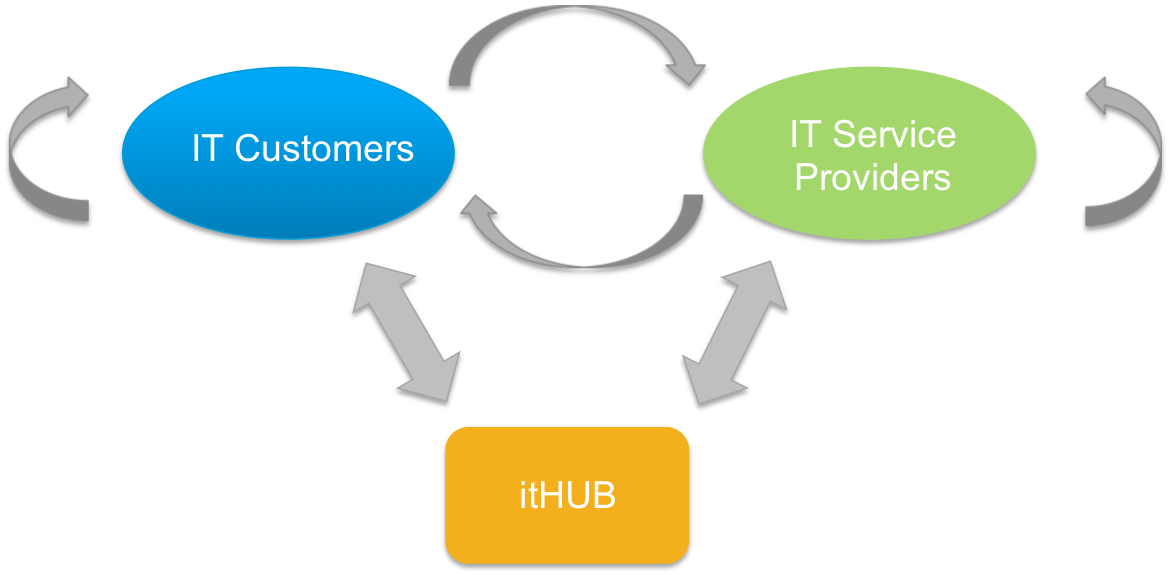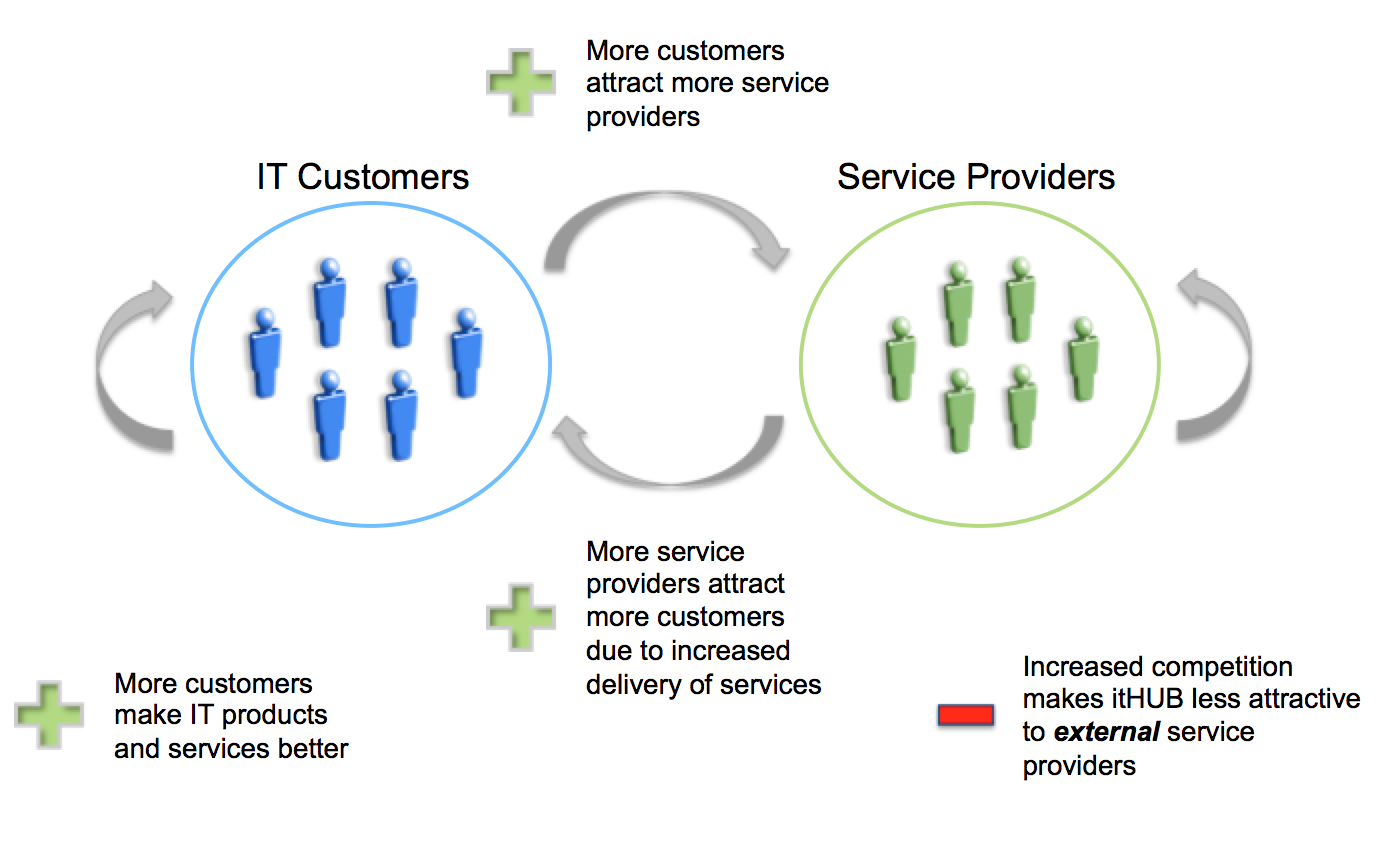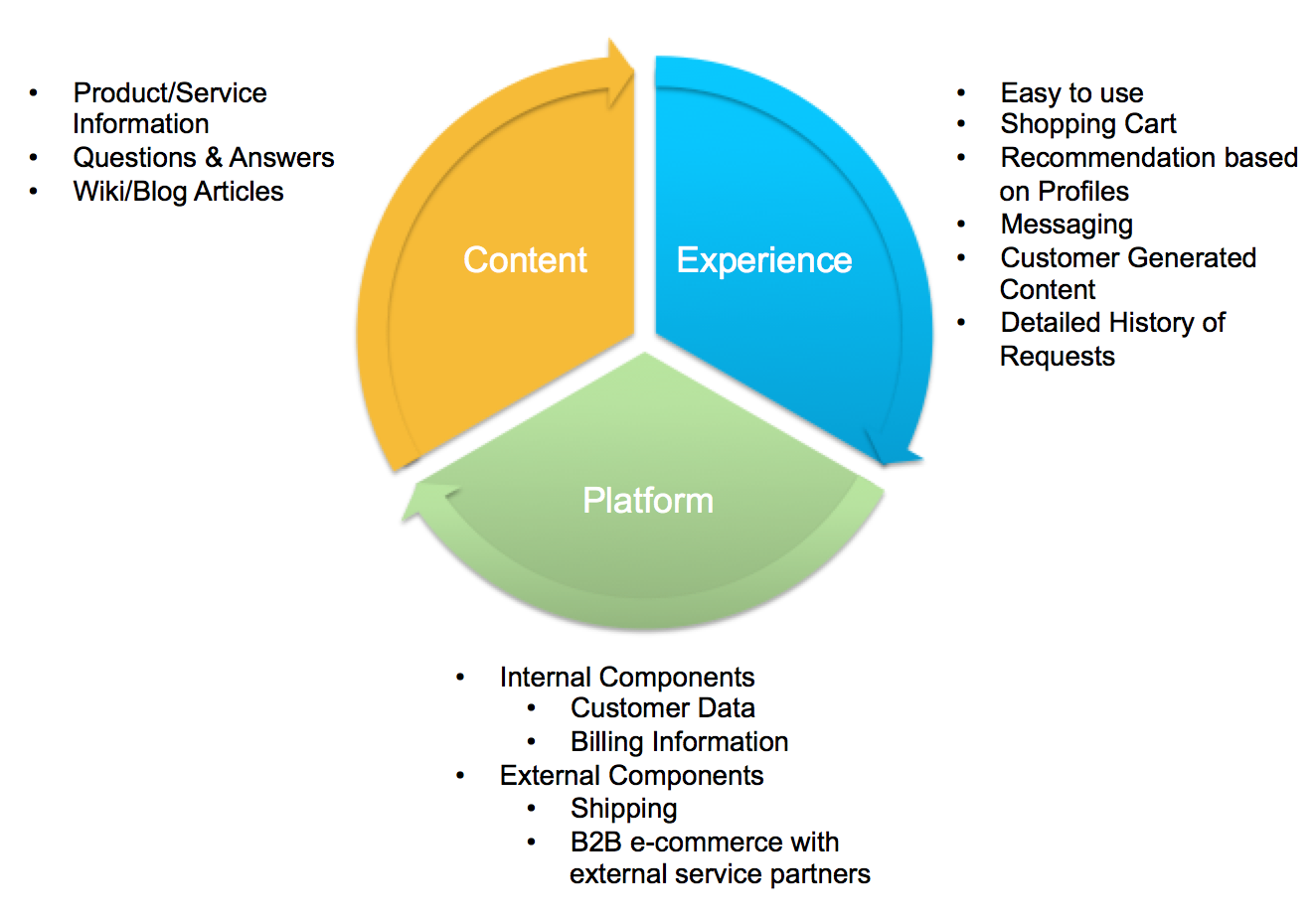Continuing from where we left off in Part 1, lets start exploring the interactive model and the need for itHUB a little more in this post.
III. INTERACTIVE MODEL
In the interactive model, the IT departments provide an e-business platform with a unified web interface to search, submit, track IT requests for their customers. The platform will also provide facilities for service providers to deliver on the requests in terms of ordering items and updating the details of the requests across multiple systems. In addition to the above requirements, the platform should also provide ways in which an IT customer can pose questions and get answers either from the other IT customers or from an IT service provider. The remainder of the article will refer to such an e-business platform as itHUB.
A. itHUB – The Platform
A two-sided platform [3] is a good starting point for itHUB. There are consumers that will request for services, check for statuses, post questions and/or answers, write blog articles, and rate the quality of services offered. There are service providers – IT departments – that fulfill requests. There are approvers – typically, managers of requestors – to approve requests made by their department users, so that the service providers can fulfill them.

In addition to IT departments, service providers can also be external vendors such as Walmart, Staples etc. Both platform provider and the sponsor could be the IT organization in question.
1) Platform Sponsor vs. Platform Provider
If the itHUB platform is built with enough abstraction, there is a possibility for IT organizations to repurpose itHUB so that it could be used as a service delivery platform for other departments. For example, a car manufacturer’s employee sales department could make use of the itHUB platform to fulfill car requests. In this particular case, the IT department will become the platform sponsor and the employee sales department will become the platform provider. The following section describes the network effects in itHUB.
2) The Network Effects
Network effect is the effect that one customer of the IT products or services has on the value of those products or services to other consumers [4]. The itHUB platform will benefit from having such network effects as shown in the next picture.
a) Same-side Network Effect
Customer-to-Customer Network effect is positive since more customers make IT products and services better. This is possible because of the interactions among the customers through social questions and answers and wikis/blogs. The more customers pose questions/answers and write blog articles about the IT products and services for clarification and usage scenarios.

Service Provider-to-Service Provider Network Effect is negative as increased competition makes itHUB less attractive to external service providers such as Walmart, Staples, and PC Connection etc. The same-side network effect among internal IT service providers is positive as the internal IT departments work with each other to deliver on the IT requests.
b) Cross-side Network Effect
Customer-to-Service Provider Network Effect is positive as more customers attract more external service providers. Service Provider-to-Customer Network Effect is positive as more service providers attract more customers as the perceived speed of delivery of IT products and services by the customers.
c) Ideas for creating and sustaining the Network Effect
IT service management is often considered a one-time deal where customers are thought to come to IT for services and go away until another need arises. Though this is true, there is an opportunity for IT departments to create a loyal customer base where not only the IT support team but also the application teams can hear about the voices of the customers in terms of application user interface design, development, and deployment. This feedback loop is valuable in terms of designing applications for the better in the future. By creating an integrated e-business platform where not only IT requests are easier to create, submit, and track, but also providing a way for the customers to receive a fast, accurate, and friendly answers [5]. In this case, it is not just the IT support team that is responsible, but the entire community of IT customers and the service providers bears the responsibility of helping each other. As long as the platform is easy to use, reaching the critical mass, unlike in a public social platform, should not be a problem for IT departments since IT customers are the employees of the organization where IT departments are a part.
When it comes to external IT service providers such as Walmart, Staples, PC Connection etc., the platform has to ensure that the “winner-takes-all” scenario does not exist [6]. This can be easily mitigated with a procurement policy.
The next section discusses a couple of digital business models that the IT departments could adapt to further sustaining the network effect.
B. The Digital Business Model
IT could employ the Click-and-Mortar (C&M) business model [7] where it maintains a web storefront in addition to its physical office space. IT must exercise the Infomediary model [7] to facilitate transactions between the consumers and the external service providers such as Walmart, Staples, PC Connection etc. To facilitate the social interactions among its customers and the service providers, IT could employ the Community model [7]. Each business model – C&M, Infomediary, and Community – can be implemented in terms of content, customer experience, and the platform [8] and built into itHUB as follows:

1) Content
- Product/Service information.
- IT related products and services information include description, images and videos, price, policies, and procedures for hardware, software, and applications offered by the IT department.
- External service provider catalog.
- This requires an integration of itHUB with the external service provider’s e-catalog and order placement solutions.
- Questions and Answers
- Questions and answers could also be posted by IT personnel in addition to being posted by the customers (user-generated)
- Questions and answers are related to the products and services offered by the IT department and the external service providers
- IT Product/Service related wikis and blog articles
- HOW-TO articles describing the usage of a particular hardware, software, or applications with images and videos
- For example, virus outbreaks and mitigation
- HOW-TO articles describing the usage of a particular hardware, software, or applications with images and videos
2) Customer Experience
- Easy-to-use
- To create and sustain the network effect as described in the previous section, itHUB has to employ good usability guidelines
- For example, 1-click request submission when the customer profile is completely known
- If the customer is a new hire, allow ways in which multiple related items could be ordered in one request
- This is an example of a composite request where several individual requests are added to one parent request
- To create and sustain the network effect as described in the previous section, itHUB has to employ good usability guidelines
- Shopping cart
- itHUB must provide a way to instruct the customers regarding the number of items and the prices that they are about to request
- There should be a way to save a set of items for later submission
- There should be a way to save and send a set of items for a different customer to submit the order
- Cost center / Project-based billing
- itHUB must have access to the billing information of the customer to facilitate ordering price-based items
- Messaging
- Email/SMS acknowledgement
- Whenever a request is placed and until the request is completely satisfied, itHUB must notify the requestor regularly through emails or text messages
- Alerts
- Notify the requestor whenever approval/rejection workflow is carried out
- Email/SMS acknowledgement
- Customer generated Content
- Ratings and reviews
- Provide a way for customers to rate/review the products and services they received
- This is an important feedback mechanism by which IT departments can and will learn about the products and services they are offering
- Sentiment Analysis can be carried out on the reviews to figure out the satisfaction levels of customers
- Questions and Answers (Q&A)
- Q&A is a great way to create the network effect described in the previous section
- Provide a way for customers to rate/review the products and services they received
- Ratings and reviews
- Detailed history of requests
- This is a great way to promulgate the amount of work IT has done to its customers, business units, and the entire organization
- Keeping track of the detailed history of requests along with comments, ratings, reviews etc. will provide IT an opportunity to infer the seasonality, satisfaction levels of customers, improvement needs among others
- Tailored recommendations based on the customer profile or the business unit
- This feature is a differentiator in which the itHUB will be perceived as a platform that understands the needs of its customers
3) Platform
- Internal components
- Customer data
- Address along with location, building, and floor
- Customer’s position or title and department
- To facilitate the approval process, the customer’s title is important
- Customer Billing Information
- Cost center, inter order number, project number are some of the attributes that are needed to be captured for the purposes of billing the customer
- Customer data
- External components
- Shipment of physical products to remote locations using UPS, FedEx etc.
- In a geographically separated organizations, IT must take shipment of items to respective business units into account
- Product and Services data from external service providers such as Walmart, Staples, and PC Connection
- This is the crux of enabling B2B commerce with the external service providers
- Shipment of physical products to remote locations using UPS, FedEx etc.
I’ll contiunue my discussion in the next post.
[3] Wikipedia. (2013). Two-sided market. Available: http://en.wikipedia.org/w/index.php?title=Two-sided_market&oldid=565480518
[4] Wikipedia. (2013). Network effect. Available: http://en.wikipedia.org/w/index.php?title=Network_effect&oldid=571703046
[5] InsideIntercom. (2013). How The Support Team Improves The Product - Inside Intercom. Available: http://insideintercom.io/how-the-support-team-improves-the-product
[6] InsideIntercom. (2012). Surviving & Thriving in Two-Sided Markets. Available: http://insideintercom.io/surviving-thriving-in-two-sided-markets
[7] M. Rappa. (2006). Business Models on the Web - Professor Michael Rappa. Available: http://digitalenterprise.org/models/models.html
[8] P. Weill and S. Woerner. (2013). Optimizing Your Digital Business Model - MIT Sloan Management Review. Available: http://sloanreview.mit.edu/article/optimizing-your-digital-business-model
